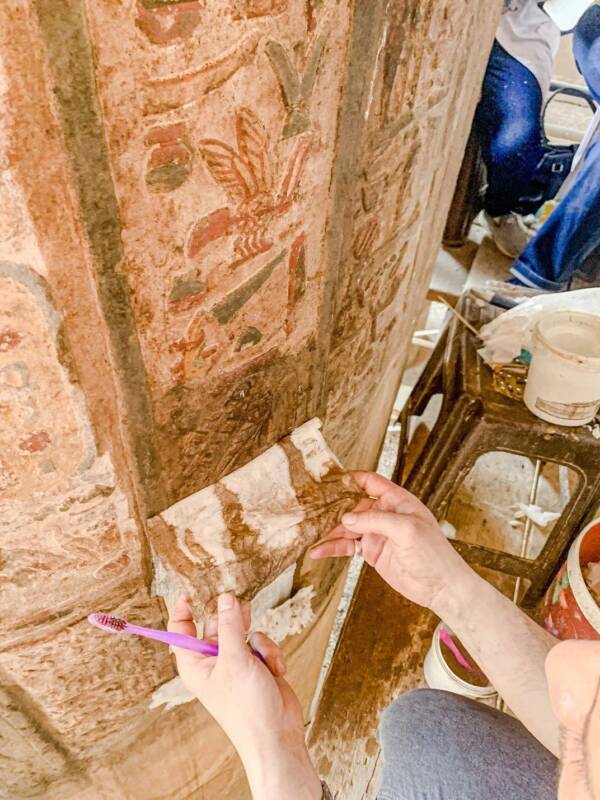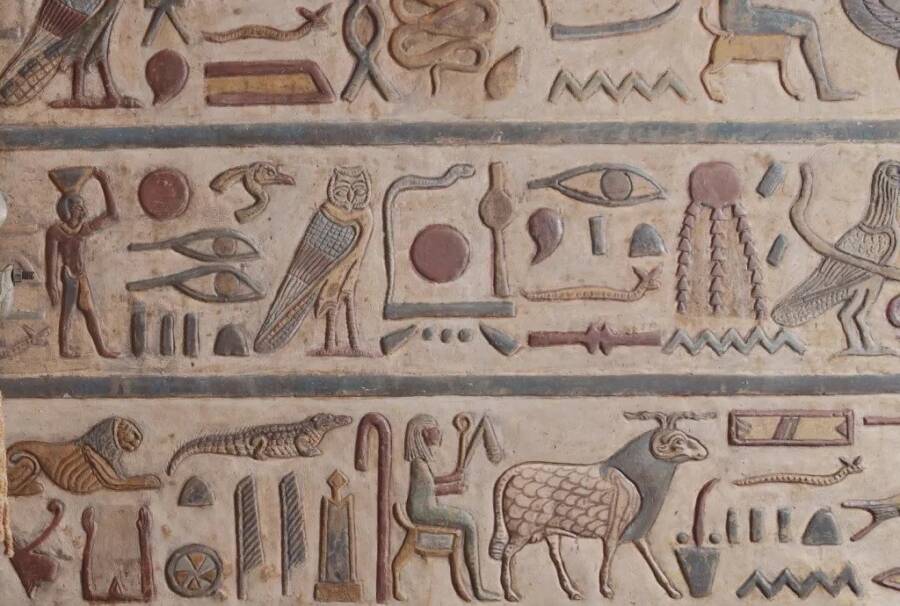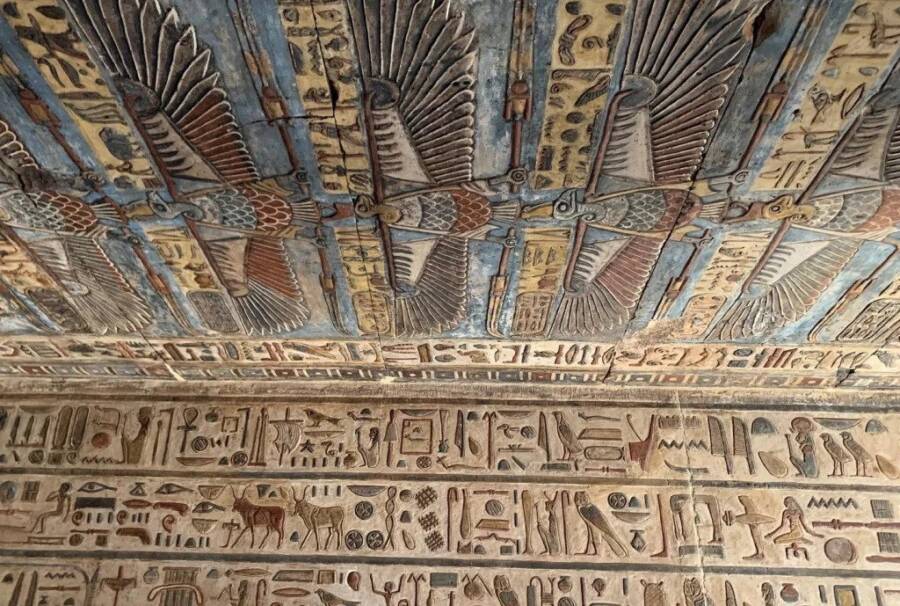The frescoes at the temple in Esna, Egypt, were made some 2,200 years ago, and the temple itself was used for four centuries.

Egyptian Ministry of Tourism and AntiquitiesOne of the colorful frescoes revealed by the restoration project.
For centuries, dirt, soot, and bird poop accumulated on the walls of the Temple of Khnum at Esna. But now, a team of German and Egyptian archaeologists is working to painstakingly clean the site, exposing the stunning and vibrant frescoes of goddesses that long lay beneath.
“Temples and ancient depictions of the gods were often painted in brilliant colors, but these have usually faded or even disappeared totally as a result of external influences,” explained Christian Leitz, a professor and director of the Department of Egyptology at Germany’s University of Tübingen and a member of the team that helped clean the temple, in a statement.
According to Smithsonian magazine, Leitz and his team used toothbrushes and alcohol to remove centuries of build-up from the temple walls, starting in 2018. Their delicate work was slowly but surely rewarded as the team uncovered 46 depictions of Egyptian goddesses portrayed in vibrant color.
Leitz explained that the reliefs depict two Egyptian goddesses in particular: the Upper-Egyptian vulture goddess Nekhbet and the Lower-Egyptian serpent goddess Wadjet.
Both, the university statement explains, are depicted as vultures with outspread wings. But Nekhbet has the white crown of Upper Egypt, while Wadjet has the head of a cobra and wears the crown of Lower Egypt.
The “extraordinary [thing] here are the colors,” Leitz raved to Live Science.

University of TübingenA German-Egyptian team used alcohol and toothbrushes to carefully clean the ancient frescoes, which had been preserved in part by layers of soot and bird poop.
According to Live Science, the temple frescoes were created some 2,200 years ago. The temple itself was used for about 400 years, between the reign of the pharaoh Ptolemy VI (180 B.C.E. to 145 B.C.E.) and the Roman emperor Decius (249 to 251 C.E.). Today, only the vestibule — which is 121 feet long, 66 feet wide, and 49 feet tall — survives. Researchers suspect that it may have been a later addition to the temple.
The temple itself, located along the Nile River, was originally dedicated to the ram-headed fertility god Khnum. According to Heritage Daily:
“Khnum was one of the earliest-known Egyptian deities, originally the god of the source of the Nile and the creator of the bodies of human children (which he made at a potter’s wheel). He was later described as having molded the other deities, and he had the titles ‘Divine Potter’ and ‘Lord of created things from himself.'”
The temple was also dedicated to Khnum’s consorts Menhit and Nebtu, his son Heka, and the goddess Neith. Menhit was a goddess associated with war, Heka a god associated with magic and medicine, and Neith the patroness of the city of Sais.

Egyptian Ministry of Tourism and AntiquitiesHieroglyphics at the Temple of Khnum.
Though the temple sits about 30 feet below street level today, it was extensively documented in the 1960s and 1970s by French Egyptologist Serge Sauneron. ArtNews reports that he took note of the temple’s engravings but didn’t see the frescoes, which were covered with dirt and animal excrement.
“For the first time we can see all the decorative elements in relation to one another,” Leitz said in the University of Tübingen statement. “This was impossible simply with Sauneron’s publication.”

Egyptian Ministry of Tourism and AntiquitiesAbout half of the temple ceiling and eight of its 18 columns have been cleaned.
The frescoes weren’t the only thing that the team found. In addition, they uncovered Greek inscriptions dating back to the reign of Roman Emperor Domitian (81-96 C.E.). ArtNews reports that the inscriptions seem to record the temple’s date of completion in both ancient Egyptian and Coptic calendars.
But as exciting as the find at the temple in Esna is, researchers still have more work to do. They plan to translate the inscriptions they found and study the connection between the inscriptions in the temple and the depictions on the temple walls.
The University of Tübingen also notes that the team only cleaned a part of the temple. They’ve worked on about half of the ceiling and eight of the temple’s 18 columns. As such, it’ll take more time — and careful cleaning — to see how this striking temple once appeared to ancient Egyptians.
After reading about the beautiful Egyptian frescoes unearthed in Esna, look through these stunning photos of Egypt before the British occupation. Or, enjoy these fascinating facts about ancient Egypt.





